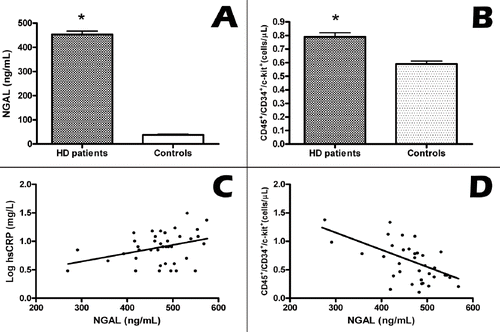NGAL: A New Missing Link between Inflammation and Uremic Anemia?
Dear Editors,
Anemia, a condition frequently observed among chronic hemodialysis (HD) patients, constitutes an important cause of morbidity and mortality. Despite the deficiencies of erythropoietin and iron representing the main causes, several other factors related to uremia can contribute to the impairment of hematopoiesis; most of these are, unfortunately, unknown at present.
Physiologically, hematopoiesis takes place within the bone marrow microenvironment, and hematopoietic stem cells (HSCs) are the source of all mature blood cells. While maturing in the circulation, HSCs are characterized by the gradual expression of surface markers, such as CD45, CD34 and c-Kit.[Citation1] The CD45 and CD34 proteins identify early hematopoietic precursors, whereas the expression of c-Kit (a tyrosine kinase receptor) is critical for proliferation, survival, and differentiation of HSCs and for erythroid cell development.[Citation2]
Recently, clinical nephrology has discovered neutrophil gelatinase-associated lipocalin (NGAL), a small inflammatory cytokine, as one of the most promising biomarkers in the diagnostic field of kidney diseases. NGAL can predict the early onset of acute kidney injury after treatments potentially detrimental to kidney, as well as the progression of chronic renal diseases.[Citation3,Citation4]
However, other parallel studies have uncovered the unexpected property of this factor to physiologically inhibit human erythropoiesis: NGAL, produced and released by the same erythroid precursors in the bone marrow, blocks their growth and differentiation and induces apoptosis through an inhibitory auto-feedback.[Citation5]
We thus aimed at evaluating circulating NGAL (using a commercial available ELISA assay; Bioporto, Gentofte, Denmark) and HSCs (CD45+/CD34+/c-kit+) levels (quantified by flow cytometric analysis, EPICS-XL Beckman-Coulter®) in a small cohort of 40 chronic HD patients (age: 54 ± 16; dialysis vintage: 41 mo.[8–122]; spKt/V: 1.4 ± 0.7) in order to assess their eventual reciprocal relationships, as well as the potential clinical relevance.
HD patients showed increased NGAL values compared to healthy subjects (453 ± 90 vs. 38 ± 13 ng/mL; p = 0.01) as well as HSCs levels (0.79 ± 0.19 vs. 0.59 ± 0.09 cells/μL; p = 0.04). Direct significant correlations were reported between NGAL and hsC-reactive protein (R = 0.31; p = 0.03), serum ferritin (R = 0.21; p = 0.04), and erythrocyte sedimentation rate (R = 0.20; p = 0.04), three well-known indexes of systemic inflammation; on the contrary, an interesting close inverse relationship was found between NGAL and HSCs levels (R = −0.41; p = 0.02; see ).
Figure 1. (A) Differences in NGAL values between HD patients and controls, p = 0.01. (B) Differences in HSCs (CD45+/CD34+/c-kit+) levels between HD patients and controls, p = 0. 04. (C) Correlation between NGAL and hsC-reactive protein, R = 0.31, p = 0.03. (D) Correlation between NGAL and HSCs, R = −0.41, p = 0.02.

Collectively, these data show another important proof of the altered hematopoietic activity present in HD patients. The increase in HSCs may reflect a sustained effort to contrast anemia but also represent a defective capacity of these cells to originate mature and functional erythrocytes, similarly to what has previously been described regarding circulating endothelial precursor cells.[Citation6,Citation7] Furthermore, the close inverse correlation between NGAL and HSCs gives a clinical dimension to experimental evidence for the first time, confirming this protein as a potential inhibitor of erythrocyte maturation. In particular, NGAL could represent a new missing link between chronic inflammation and impaired bone marrow activity in uremia. Further studies are required to establish the potential utility of NGAL and HSCs measurement in the management of anemia in HD patients, and to evaluate if future therapeutic measures targeting NGAL levels would be useful to ameliorate this same condition.
REFERENCES
- Wognum AW, Eaves AC, Thomas TE. Identification and isolation of hematopoietic stem cells. Arch Med Res. Nov–Dec, 2003; 34(6)461–475
- Wright DE, Wagers AJ, Gulati AP, Johnson FL, Weissman IL. Physiological migration of hematopoietic stem and progenitor cells. Science. 2001; 294: 1933–1936
- Bolignano D, Lacquaniti A, Coppolino G, Donato V, Campo S, Fazio MR, Nicocia G, Buemi M. Neutrophil gelatinase-associated lipocalin (NGAL) and progression of chronic kidney disease. Clin J Am Soc Nephrol. Feb, 2009; 4(2)337–344
- Bolignano D, Donato V, Coppolino G, Campo C, Buemi A, Lacquaniti A, Buemi M. Neutrophil gelatinase-associated lipocalin (NGAL) as a marker of kidney damage. Am J Kidney Dis. 2008; 52: 595–609
- Miharada K, Hiroyama T, Sudo K, Danjo I, Nagasawa T, Nakamura Y. Lipocalin 2-mediated growth suppression is evident in human erythroid and monocyte/macrophage lineage cells. J Cell Physiol. May, 2008; 215(2)526–537
- Sturiale A, Coppolino G, Loddo S, Criseo M, Campo S, Crascì E, Bolignano D, Nostro L, Teti D, Buemi M. Effects of hemodialysis on circulating endothelial progenitor cell count. Blood Purif. 2007; 25(3)242–251
- Coppolino G, Bolignano D, Campo S, Loddo S, Teti D, Buemi M. Circulating progenitor cells after cold pressor test in hypertensive and uremic patients. Hypertens Res. Apr, 2008; 31(4)717–724
